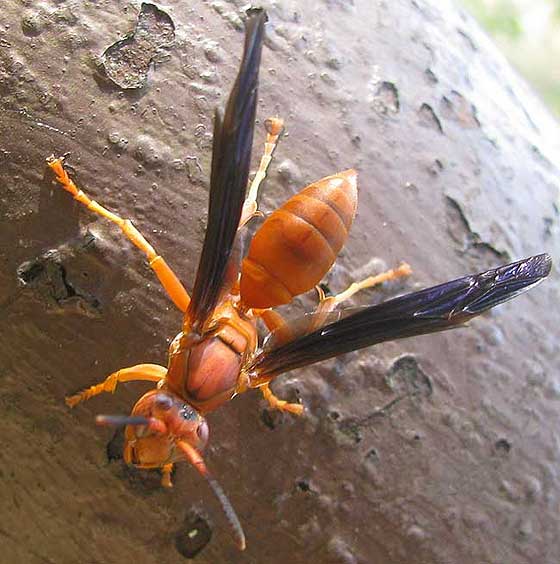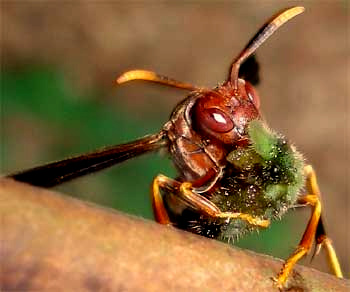
The Weird & Wonderful World of 

First of all, to the non-specialist, the boundary between what's a wasp, a bee, and even an ant (all members of the Hymenoptera) isn't at all clear. The many families at first glance seem to blend into one another. Moreover, the people who gave insects their English names were not specialists. For example, Velvet Ants are actually wingless wasps.
Here are some of the most commonly noticed wasp families:
A while back, living in southwestern Mississippi, I ran into an extremely aggressive "paper wasp" I wasn't able to identify. One day I made contact with a real wasp specialist, Dr. Joy Layton, who figured out that the aggressive wasp was a Paper Wasp of the genus Polistes. Dr. Layton told me a good bit about Polistes and I include that information below just so you can see the kind of stuff that can be known about a randomly selected wasp species that just happens to be around you.
 Polistes wasp carrying home a stung cterpillar; image contributed by May Lattanzio
Polistes wasp carrying home a stung cterpillar; image contributed by May LattanzioFirst, note the photo at the right.
Dr. Layton wrote:
There are many temperate zone Polistes species. Among the Polistes everybody dies in late fall/early winter EXCEPT the new queens. They mated with males of their species in September/October, often swarming around fields of blooming goldenrods and other wildflowers. This is the only time of year that you'll find males, and they look a lot like the females, only that their antennae are more curved and their faces tend to have lighter colors.
The mated queens then seek hibernation sites, which tend to be protected, but cool enough to keep the queens dormant so that they don't use up their stored body fat. Often young queens crawl into crevices in the eaves of buildings, go too far in and get inside somebody's house, then they fly around and get mashed by the human occupants! If they find the right spot, they just stay dormant until spring.
In early spring they fly out, feed on nectar from whatever flowers are in bloom and start a small paper nest. It is almost always one queen with one nest- no sharing! Each early-season nest is tiny and usually overlooked by humans. These young queens are usually rather timid and docile -- their best strategy being to remain unobserved and nonaggressive until they can raise their first generation of offspring to be the workers that will expand the nest, forage for food and protect the colony.
A spring wasp nest is small and completely unprotected while the new queen is off foraging for food for her larvae. She must feed them on caterpillars she's captured and butchered. Her larvae are helpless, legless white grubs which look nothing like a wasp. After about three to four weeks, these grubs pupate and emerge as new workers. They are all female and all sterile. Besides, there are no males alive to mate with anyway, so these workers will not lay eggs but will devote their lives to raising the next set of eggs of the queen.
In other words, the queen has raised the first brood to be a bunch of old maids who will devote themselves to raising their younger sisters. These workers too tend to be relatively docile. They are small and while they will protect the nest if they have to they don't go looking for trouble. The queen no longer leaves the nest, but keeps laying eggs as the workers expand the nest and forage and feed the larvae and the queen.
The next set of larvae that mature will also probably be sterile workers. But somewhere around the 3rd or 4th set of larvae (called "broods") the females that emerge are larger and bolder. They may still be sterile workers but they are more aggressive.
By now, it is late summer and this is when people suddenly notice the wasp nests on the eaves of their porches and declare that they "just sprung up overnight!" Of course the colony has been there all along but now it is bustling and much more apparent. July and August are when the colonies usually reach these aggressive proportions. Workers on these late summer nests are much more willing to jump off the nest and attack you just because you're in their space- and their perception of that space has expanded.
You can stand within a couple of feet of a spring/early summer nest and the workers will not fly at you. They'll watch you, orienting themselves to keep their eyes on you, but usually that is all. But the workers of those same nests in late summer will spring off the nest at the mere approach of a human and sting! And they may go off looking for trouble even far away from the nest.
The set of larvae that these aggressive workers are raising will emerge as young queens and males. The virgin queens look just like the workers, maybe a little larger, but not always. Males I've described. The virgin queens don't forage or build the nest but usually just hang out until time to fly off and find mates. There seems to be no mating going on on the nest (which would be between sisters and brothers) but only off in the fields of wildflowers of the season, a good way to avoid inbreeding.
After the virgin queens and males fly off, the colony declines, fewer eggs/larvae are present and the old queen dies either before cold weather or the first frost or so. The workers die. The nest is empty and deserted, never to be reused.
Then it all repeats.